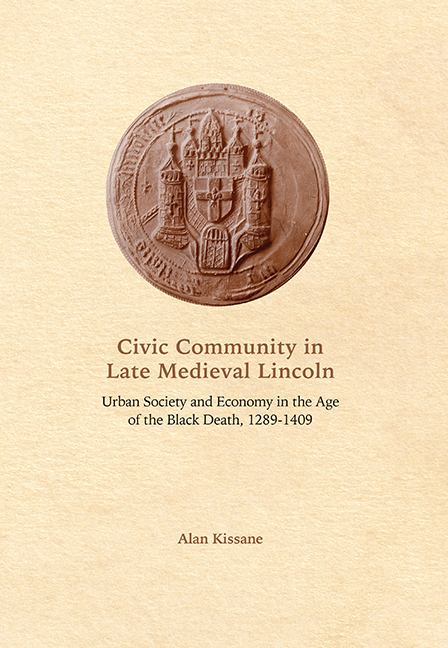 Civic Community in Late Medieval Lincoln
Civic Community in Late Medieval Lincoln Book contents
- Frontmatter
- Contents
- List of Illustrations
- Acknowledgements
- Abbreviations and Note on the Text
- Introduction
- 1 Urban Foundations: Occupational Structure
- 2 Lincoln as Entrepôt: Tolls, Trade and Credit
- 3 The Crown and the Fee Farm
- 4 The Growth of Civic Government
- 5 Fraternity, Orthodoxy and Communal Cooperation
- 6 Chantry Founders, Commemoration and the Rental Market
- Conclusion
- 1 Appendix 1: Occupational Sources and Data
- 2 Appendix 2: Lincoln Civic Officials, 1289-1409
- 3 Appendix 3: Lincoln Members of Parliament, c.1290-1410
- 4 Appendix 4: The Fraternal Year
- 5 Appendix 5: Perpetual Chantry Foundations
- Bibliography
- Index
6 - Chantry Founders, Commemoration and the Rental Market
Published online by Cambridge University Press: 27 April 2017
- Frontmatter
- Contents
- List of Illustrations
- Acknowledgements
- Abbreviations and Note on the Text
- Introduction
- 1 Urban Foundations: Occupational Structure
- 2 Lincoln as Entrepôt: Tolls, Trade and Credit
- 3 The Crown and the Fee Farm
- 4 The Growth of Civic Government
- 5 Fraternity, Orthodoxy and Communal Cooperation
- 6 Chantry Founders, Commemoration and the Rental Market
- Conclusion
- 1 Appendix 1: Occupational Sources and Data
- 2 Appendix 2: Lincoln Civic Officials, 1289-1409
- 3 Appendix 3: Lincoln Members of Parliament, c.1290-1410
- 4 Appendix 4: The Fraternal Year
- 5 Appendix 5: Perpetual Chantry Foundations
- Bibliography
- Index
Summary
Recorded in the chapter house at Lincoln cathedral on 15 April 1352, Robert de Dalderby's charter began
I, Robert de Dalderby [mayor 1341/42], citizen of Lincoln, ordain and constitute two perpetual chantries in the church of St Benedict in the city of Lincoln and two chaplains, one who shall be warden, and the other who shall be his fellow, to celebrate at the altar of the blessed Mary in the said church. I appoint Ralph de Thymelby, chaplain, to be warden, and Sir Robert de Thymelby, chaplain, to be fellow to him, that they and their successors may celebrate for me and the souls of whom mention is made below …
Further to this short preamble, Dalderby's charter recorded extensive details of the financial provisions and living arrangements for the two chaplains, including a list of their duties, services to be performed and items bequeathed for the purpose, rules regarding the physical upkeep of the endowed lands, the right of presentment and the names of the beneficiaries of the intercessory masses. Less than ten years earlier on 19 July 1344 a similar, albeit much shorter, set of provisions recorded in the testament of Walter son of William de Launesdale (bailiff 1337/38) were ratified in the Burwarmote Court. According to Walter's will, Joan, his wife and executor, was to sell his messuage in the parish of St Peter in the Skinmarket and with the monies find two fitting and honest chaplains to celebrate divine offices in the church of St Peter for one year for his soul and those of his late wife Ellen, his father and mother and all their benefactors. No other details were provided.
Both documents, whilst clearly differing in their overall content and detail, represent well the types of evidence used to explore the importance of chantry foundations in the later Middle Ages, which, from at least the beginning of the thirteenth century, grew in great popularity throughout England.
- Type
- Chapter
- Information
- Civic Community in Late Medieval LincolnUrban Society and Economy in the Age of the Black Death, 1289-1409, pp. 199 - 234Publisher: Boydell & BrewerPrint publication year: 2017


